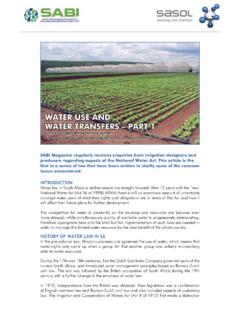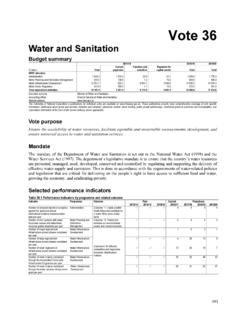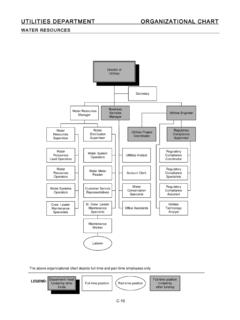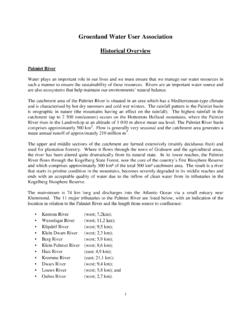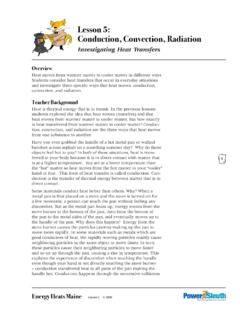Transcription of 7 coping with water scarcity
1 World water day20 72 2 n d M a r c h 2 0 0 7c o p i n g w i t h w a t e r s c a r c i t yc h a l l e n g e o f t h e t w e n t y - f i r s t c e n t u r yWorld water Day 20072 ContentsIntroduction 3 The multiple dimensions of water scarcity 4 The vicious cycle of water and poverty an issue of life and livelihood 8 Growing demand for a finite resource 9 Sharing water a cause of conflict or an opportunity to cooperate? 12 water in rural areas issues of vulnerability and sustainability 13 Climate change more troubled waters ahead 15 The way forward we can do much better 16 Improving investments in water to reach the Millennium Development Goals 17 Improving health through better access to water 20 Producing more with less water 21 Managing uncertainty for the benefit of the poor 23 Valuing social and environmental services 25 Making water scarcity everybody s business 26 Main references 28 Useful web sites 29 coping with water scarcity - Challenge of the twenty-first
2 Century3 Introduction22 March is World water Day, a day for reflection and for action to address the pressing issues related to the world s water resources. Coordinated by the Food and Agriculture Organization on behalf of the 24 Agencies and Programme Members of UN- water , World water Day 2007 will be marked in many countries in diverse ways. The theme of World water Day 2007 is coping with water scarcity . water scarcity affects all social and economic sectors and threatens the sustainability of the natural resources base. Addressing water scarcity requires an intersectoral and multidisciplinary approach to managing water resources in order to maximize economic and social welfare in an equitable manner without compromising the sustainability of vital ecosystems.
3 Integration across sectors is needed. This integration needs to take into account development, supply, use and demand, and to place the emphasis on people, their livelihood and the ecosystems that sustain them. On the demand side, enhancing water productivity (the volume of production per unit of water ) in all sectors is paramount to successful programmes of water scarcity alleviation. Furthermore, protecting and restor-ing the ecosystems that naturally capture, filter, store and release water , such as rivers, wet-lands, forests and soils, is crucial to increasing the availability of water of good are divided on whether the world is facing a water crisis today.
4 Those who believe so can point with justification to the accumulation of reports throughout the world. For example, in just one week in mid-November 2006, national media sources reported local but high-profile shortages in parts of Australia, Botswana, Canada, China, Fiji, Kuwait, Liberia, Malawi, Pakistan, Philippines, South Africa, Uganda, United Arab Emirates and United States of America. Then there are the silent crises, the millions of people deprived of the water they need to live and to sustain their livelihood. It is indeed a powerful argu-ment that a global crisis need not stem from a single cause with widespread impact alone, but rather that a crisis can be made up of many similar incidents across the globe, even if the incidents are isolated from one another.
5 Conscious of the increasing pressure on limited water resources, UN- water has identified water scarcity as the theme for World water Day 2007. This day will provide an opportu-nity to reflect on the challenges posed by the unsustainable increase in water use and its degradation across the globe. It will also serve as a spur to action to reverse current trends and work towards a more efficient and more equitable distribution of water for all. World water Day 20074 The multiple dimensions of water scarcityWater is essential for all socio-economic development and for maintaining healthy ecosys-tems.
6 As population increases and development calls for increased allocations of ground- water and surface water for the domestic, agriculture and industrial sectors, the pressure on water resources intensifies, leading to tensions, conflicts among users, and excessive pressure on the environment. The increasing stress on freshwater resources brought about by ever-rising demand and profligate use, as well as by growing pollution worldwide, is of serious are several ways of defining water scarcity . In general, water scarcity is defined as the point at which the aggregate impact of all users impinges on the supply or quality of water under prevailing institutional arrangements to the extent that the demand by all sec-tors, including the environment, cannot be satisfied fully.
7 water scarcity is a relative con-cept and can occur at any level of supply or demand. scarcity may be a social construct (a product of affluence, expectations and customary behaviour) or the consequence of altered supply patterns stemming from climate change for example. scarcity has various causes, most capable of being remedied or alleviated. A society facing water scarcity usu-ally has options. However, scarcity often has its roots in water shortage, and it is in the arid and semi-arid regions affected by droughts and wide climate variability, combined with high population growth and economic development, that the problems of water scarcity are most of water scarcity include severe environmental degradation (including river des-iccation and pollution), declining groundwater levels, and increasing problems of water allocation where some groups win at the expense of others.
8 A major study, the Comprehensive Assessment of water Management in Agriculture, reveals that one in three people today face water shortages (CA, 2007). Around billion people, or almost one-fifth of the world s population, live in areas of physical scarcity , and 500 million people are approaching this situation. Another billion people, or almost one quarter of the world s population, face economic water shortage (where countries lack the necessary infrastructure to take water from rivers and aquifers).Imbalances between availability and demand, the degradation of groundwater and surface water quality, intersectoral competition, and interregional and international conflicts, all bring water issues to the with water scarcity - Challenge of the twenty-first century5UN-WaterUN- water is the mechanism coordinating the actions of the United Nations (UN) system aimed at implementing the agenda set by the Millennium Declaration and the World Summit on Sustainable Development (WSSD) in all aspects related to freshwater.
9 UN- water has grown out of many years of extensive collaboration and partnership among the UN Agencies. These efforts have helped to achieve significant progress and to bring water and water -related issues to the top of the political agenda. The large number of UN Agencies dealing with water reflects the multiple roles water plays in our societies and the complex interactions it implies. Advancing the implementation of sustainable water management for the benefit of all is a collective responsibility and challenge. It calls for coordinated action within the UN system and with other partners and stake-holders including organizations from the public and private sectors, civil society and labour as part of a global, comprehensive main purpose of UN- water is to complement and add value to existing programmes and projects by facilitating synergies and joint efforts in order to maximize the coher-ence and effectiveness of the support provided to countries pursuing the goals agreed upon by the international community.
10 This is in line with the integrated water resources management (IWRM) approach, which calls for collaboration among all stakeholders in water water Day 20076In most countries, the agriculture sector is the predominant consumer of water . Historical-ly, large-scale water development projects have played a major role in poverty alleviation by providing food security, protection from flooding and drought, and expanded oppor-tunities for employment. In many cases, irrigated agriculture has played a major role in the development of rural economies, supporting economic growth and poverty reduction.










